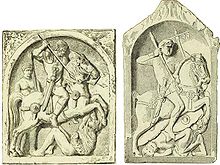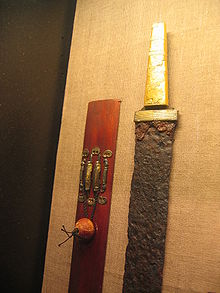- Spatha
-
The spatha was a type of straight sword, measuring between 0.75 and 1 m (30 and 39 in),[dubious ] in use throughout first millennium AD Europe, and in the territory of the Roman Empire until about 600 AD. Later swords from 600 AD to 1000 AD are recognizable derivatives, though they are not spathae.
The spatha was used in gladiatorial fights and in war. The spatha of literature appears in the Roman Empire in the first century AD as a weapon used by presumably Germanic auxiliaries[dubious ] and gradually became a standard heavy infantry weapon, relegating the gladius to use as a light infantry weapon.[dubious ] The spatha apparently replaced the gladius in the front ranks, giving the infantry more reach when thrusting. While the infantry version had a long point, versions carried by the cavalry had a rounded tip that prevented accidental stabbing of the cavalryman's foot.
Archaeologically many instances of the spatha have been found in Britain and Germany. It was used extensively by Germanic warriors. It is unclear whether it came from the Pompeii gladius or the longer Celtic swords, or whether it served as a model for the various broadswords and Viking swords of Europe. The spatha remained popular throughout the Migration Period. It may have evolved into the knightly sword of the High Middle Ages from about 1100 AD, but the large number of sword types that appeared during the period make it difficult to establish links. The details of their manufacture remain mostly unknown.
Contents
Etymology
The word comes from the Latin spatha,[1] which derives from Greek σπάθη (spáthē), meaning "any broad blade, of wood or metal" but also "broad blade of a sword".[2]
The Greek word σπάθη was used in the middle Archaic period for various types of Iron Age swords. The word does not appear in Homeric Greek, but it is mentioned in the works of Alcaeus of Mytilene (sixth century BC)[3] and Theophrastus (fourth century BC).[4]
It is likely that spatha is the romanization of the Doric Greek *σπάθα (spáthā), considering the Doric acc. plural "σπάθας" (spáthās).[5] The word survives in Modern Greek as σπάθη and σπαθί. The Latin word became the French épée, Catalan espasa, Portuguese and Spanish espada, Italian spada, Romanian spadă and Albanian shpata, all meaning "sword". The English word spatula comes from Latin spat(h)ula, the diminutive of spatha. English spade, from Old English spadu or spædu, is the Germanic cognate, derived from a Common Germanic *spadō, ultimately from a Proto-Indo-European stem *sph2-dh-.
Roman Empire
The spatha was introduced to the Roman army in the early imperial period by Celtic cavalry auxiliaries who continued to wear their Celtic long swords, with blade lengths of 60 to 85 cm, in Roman service. The earlier gladius sword was gradually replaced by the spatha from the late second to the third century AD. From the early 3rd century AD, legionaries and cavalrymen began to wear their swords on the left side, perhaps because the scutum had been abandoned and the spatha had replaced the gladius.[6]
Employed by both Roman cavalrymen and their German enemies, later Lombard spathae were actually more advanced than the wrought iron gladii, being constructed using a form of pattern welding employing layers of iron and steel; in effect, a composite material. Eventually under the later Roman Empire the spatha was adopted by many if not all legionaries.
In the imperial period, the Romans adopted the original Greek term, spathe (σπάθη), as spatha, which still carried the general meaning of any object considered long and flat.[7] Spatha appears first in Pliny and then Seneca with different meanings: a spatula, a metal-working implement, a palm-leaf and so on.[8] There is no hint of any native Roman sword called a spatha.
Referring to an actual sword, the term first appears in the pages of Tacitus with reference to an incident of the early empire.[9] The British king Caractacus, having rebelled, found himself trapped on a rocky hill, so that if he turned one way he encountered the gladii of the legionaries, and if the other, the spathae of the auxiliaries. Left with no other way to turn, he escaped to the Brigantes, leaving his brothers to surrender the men. He was turned over to the Romans by the queen of the Brigantes, who was pardoned by the Senate after a moving plea for mercy, and reigned successfully once more as a Roman client king. Tacitus does not relate who the auxiliaries were. The Romans moved auxiliaries around the frontiers and also relied on local levies. Most examples of spathae come from Germany and east Europe, however. There is an excellent chance that the owners of the spathae were Germanic. There is no indication in Tacitus either that they were cavalry; overall, the Romans used both cavalry and infantry.
When the spathae next appeared, after a mysterious lacuna of about two centuries, they became the standard weapon of heavy infantry.[10] The Romans could have borrowed this weapon from the auxiliaries, probably Germanic mercenaries, but the name does not support this origin. Spatha was certainly not a Germanic name, nor is there any indication anywhere what its Germanic name was. There are a plenitude of Germanic names, such as Old English sweord, bill, and so on, but no evidence to tie any name to the spatha, which was never used in Germanic languages as the name of a sword.
Roman Iron Age
The Roman Iron Age refers approximately to the time of the Roman Empire in north Europe, which was outside the jurisdiction of the empire, but, judging from the imported Roman artifacts, was influenced by Roman civilization. One source of artifacts from this period are the bogs of Schleswig, Holstein and Denmark. Objects were deliberately broken and thrown into the bog so that they could go with a deceased chief on his voyage to a better place.
- A cache of 90 swords was found at Nydam Mose in Denmark in 1858. They were in the form of the spatha and therefore have been classified as "Roman swords". They are dated between 200 AD – 400 AD. Many connect the Nydam cache with the sword of Beowulf, who was supposed to be a contemporary.[11]
Migration period
Main article: Migration Period swordSurviving examples of these Germanic Iron Age swords had blades measuring between 710 and 810 mm (28 and 32 in) in length and 43 to 61 mm (1.7 to 2.4 in) in width. These single handed weapons of war sported a tang only some 100 to 130 mm (3.9 to 5.1 in) long and had very little taper in their blades. They usually ended in a rounded tip.
Viking Age
Main article: Viking swordPerhaps the most distant recognizable cousins to the spatha were the Viking Age blades. These swords took on a much more acute distal taper and point. These blades had deep fullers running their length, yet still had single-handed hilts which sported a unique shaped pommel, flat at the grip side and roughly triangular early on, with the flat curving to fit the hand later. While the pattern of hilt and blade design of this type might readily be called "the Viking sword", to do so would be to neglect the widespread popularity it enjoyed. All over continental Europe between 700 AD and 1000 AD, this design and its variations could be found. Many of the best blades were of Frankish origin, hilted in local centres. These blades had significantly better balance. Many Saxon-era blades were largely ceremonial, due to the low grade of iron and the tip-heavy balance. Viking-era blades were refined weapons.
During Norman times the blades increased some 100 millimetres (3.9 in) in overall length, and the hilt changed significantly. Instead of the Brazil-nut pommel, a thick disc-shaped pommel was attached "on-edge" to the bottom of the iron hilt. In addition the upper guard grew substantially from the near-absent design predating it. Also the blades tended to taper slightly less than those found in the time of the Vikings.
Due to the combined Greek and Roman tradition of its military, or perhaps through the Varangian Guard's presence in Constantinople, the spatha had a place within the Byzantine Empire and its army. In the Byzantine court, spatharios (σπαθάριος), or "bearer of the spatha", was a mid-level court title. Other variants deriving from it were protospatharios, spatharokandidatos and spatharokoubikoularios, the latter reserved for eunuchs. One of the more famous spatharokandidatoi was Harald Hardrada.[12]
Jan Petersen in De Norske Vikingsverd ("The Norwegian Viking Swords", 1919) introduced the most widely-used classification of swords of the Viking Age, discriminating twenty-six types labelled A – Z. In 1927 R. E. M. Wheeler condensed Petersen's typology into a simplified typology of nine groups, numbered I – IX.
Norman swords
The transition from the Viking age spatha to the High Medieval arming sword took place between the 10th and 11th centuries. The main development was the growth of the front handguard into a full cross-guard, and the reduction of the typical Viking-era lobated pommel into simpler hazelnut or disc shapes. The sword of Otto I preserved in Essen is such an example of the emerging arming sword, although it has been encrusted with decorations during the centuries it was conserved as a relic (total length 95.5 cm).[13]
Notes
- ^ spatha, Charlton T. Lewis, Charles Short, A Latin Dictionary, on Perseus Digital Library
- ^ σπάθη, Henry George Liddell, Robert Scott, A Greek-English Lexicon, on Perseus Digital Library
- ^ "Χαλκίδικαι σπάθαι" (Chalcidian spathai), Alcaeus, 15.6
- ^ Theophrastus, Characters, 25.4, original Greek text, on Perseus Digital Library
- ^ AP6.288 (Leon.) in "σπάθη" definition, LSJ
- ^ Lesley Adkins, Roy A. Adkins, Handbook to life in ancient Rome, Oxford University Press, 1998 ISBN 9780195123326, p. 87.
- ^ An online version of "Middle Liddell" is offered at http://www.perseus.tufts.edu/hopper/, referring to the middle of three sizes in which the most commonly used lexicon by Liddell & Scott has been published. The unabridged is preferable for research, as it lists all the uses in ancient Greek of the word.
- ^ An interactive Latin dictionary, Lewis & Short, based on Andrews, is given at www.Perseus.com, but any good printed Latin dictionary also states the various uses and sources of spatha.
- ^ Annales 12.35.
- ^ See the quotation from Vegetius given in the introduction to Roman military personal equipment. The use of the same name applied to the weapons of the auxiliaries is inconclusive. The Romans may merely have borrowed a Greek weapon that looked like the north European weapons.
- ^ A professional site may be found at das Nydam Moor. German is required but a good picture of a sword is shown. Another site is to be found at Genealogies, Maps, Glossary & Pictorial Guide to Beowulf. It presents the ancient Germanic sword vocabulary and shows a picture of a Nydam spatha but does not connect it to a specific name.
- ^ Kekaumenos, Strategikon, "Oration of Admonition to an Emperor", para. 81
- ^ http://freywild.ch/otto.html
See also
References
- Ewart Oakeshott, The Archaeology of Weapons, Barnes & Noble, 1994, ISBN 1-56619-596-9. The book was copyrighted in 1960.
External links
- THE NORWEGIAN VIKING SWORDS by JAN PETERSEN (1919) translated by Kristin Noer (1998)
- A RECORD OF EUROPEAN ARMOUR AND ARMS THROUGH SEVEN CENTURIES by Sir Guy Francis Laking (1919)
- Anatomy of the Sword (myArmoury.com article)
- A Sword from the Late Viking Age from the Higgins Museum (myArmoury.com article)
- VikingSword.com
- Sword Forum International
Europe Rapier · Smallsword/Dueling sword · Hunting sword · Pistol sword · Broadsword · Spadroon · Mameluke swordJapan Yayoi - Nara periodsMuromachi - Edo periodsMiddle East / Muslim world Scimitar typeSouth and East Asia Formative stageClassic stagePost-Classic stageCategories:- Roman swords
- Ancient Roman legionary equipment
- Cavalry
- Greek loanwords
Wikimedia Foundation. 2010.






